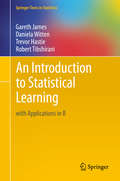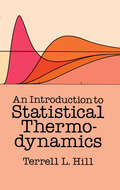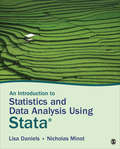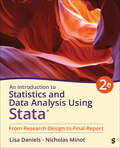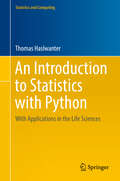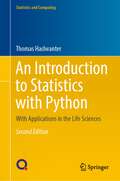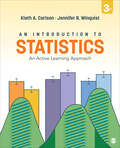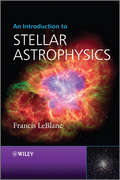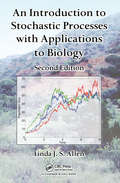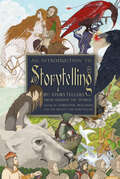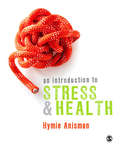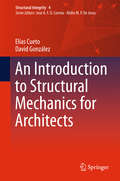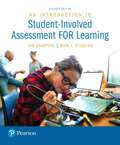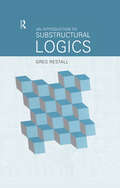- Table View
- List View
An Introduction to Statistical Learning: with Applications in R (Springer Texts in Statistics #103)
by Trevor Hastie Gareth James Robert Tibshirani Daniela WittenAn Introduction to Statistical Learning provides an accessible overview of the field of statistical learning, an essential toolset for making sense of the vast and complex data sets that have emerged in fields ranging from biology to finance to marketing to astrophysics in the past twenty years. This book presents some of the most important modeling and prediction techniques, along with relevant applications. Topics include linear regression, classification, resampling methods, shrinkage approaches, tree-based methods, support vector machines, clustering, and more. Color graphics and real-world examples are used to illustrate the methods presented. Since the goal of this textbook is to facilitate the use of these statistical learning techniques by practitioners in science, industry, and other fields, each chapter contains a tutorial on implementing the analyses and methods presented in R, an extremely popular open source statistical software platform. Two of the authors co-wrote The Elements of Statistical Learning (Hastie, Tibshirani and Friedman, 2nd edition 2009), a popular reference book for statistics and machine learning researchers. An Introduction to Statistical Learning covers many of the same topics, but at a level accessible to a much broader audience. This book is targeted at statisticians and non-statisticians alike who wish to use cutting-edge statistical learning techniques to analyze their data. The text assumes only a previous course in linear regression and no knowledge of matrix algebra.
An Introduction to Statistical Problem Solving in Geography
by J. Chapman McGrew Arthur J. Lembo Charles B. MonroeGeography students need a solid introduction to the variety of ways in which statistical procedures are used to explore and solve realistic geographic problems. This book is designed to provide a comprehensive and understandable introduction to statistical methods in a practical, problem solving framework. Students who use this text in a spatial analysis or statistical methods course should acquire a well-grounded foundation and feel comfortable in applying statistical techniques in research problems or situations that they might encounter in their subsequent geographic education and careers. This book is targeted for undergraduate geography majors and beginning graduate students who do not have a strong background in statistical approaches to geographic problem solving.
An Introduction to Statistical Thermodynamics (Dover Books On Physics Series)
by Terrell L. HillAlthough written on an introductory level, this wide-ranging text provides extensive coverage of topics of current interest in equilibrium statistical mechanics. Indeed, certain traditional topics are given somewhat condensed treatment to allow room for a survey of more recent advances.The book is divided into four major sections. Part I deals with the principles of quantum statistical mechanics and includes discussions of energy levels, states and eigenfunctions, degeneracy and other topics. Part II examines systems composed of independent molecules or of other independent subsystems. Topics range from ideal monatomic gas and monatomic crystals to polyatomic gas and configuration of polymer molecules and rubber elasticity. An examination of systems of interacting molecules comprises the nine chapters in Part Ill, reviewing such subjects as lattice statistics, imperfect gases and dilute liquid solutions. Part IV covers quantum statistics and includes sections on Fermi-Dirac and Bose-Einstein statistics, photon gas and free-volume theories of quantum liquids.Each chapter includes problems varying in difficulty — ranging from simple numerical exercises to small-scale "research" propositions. In addition, supplementary reading lists for each chapter invite students to pursue the subject at a more advanced level. Readers are assumed to have studied thermodynamics, calculus, elementary differential equations and elementary quantum mechanics.Because of the flexibility of the chapter arrangements, this book especially lends itself to use in a one-or two-semester graduate course in chemistry, a one-semester senior or graduate course in physics or an introductory course in statistical mechanics.
An Introduction to Statistics and Data Analysis Using Stata®: From Research Design to Final Report
by Lisa Daniels Nicholas W. MinotAn Introduction to Statistics and Data Analysis Using Stata® by Lisa Daniels and Nicholas Minot provides a step-by-step introduction for statistics, data analysis, or research methods classes with Stata. Concise descriptions emphasize the concepts behind statistics for students rather than the derivations of the formulas. With real-world examples from a variety of disciplines and extensive detail on the commands in Stata, this text provides an integrated approach to research design, statistical analysis, and report writing for social science students.
An Introduction to Statistics and Data Analysis Using Stata®: From Research Design to Final Report
by Lisa Daniels Nicholas W. MinotAn Introduction to Statistics and Data Analysis Using Stata® by Lisa Daniels and Nicholas Minot provides a step-by-step introduction for statistics, data analysis, or research methods classes with Stata. Concise descriptions emphasize the concepts behind statistics for students rather than the derivations of the formulas. With real-world examples from a variety of disciplines and extensive detail on the commands in Stata, this text provides an integrated approach to research design, statistical analysis, and report writing for social science students.
An Introduction to Statistics and Data Analysis Using Stata®: From Research Design to Final Report
by Lisa Daniels Nicholas W. MinotAn Introduction to Statistics and Data Analysis Using Stata®: From Research Design to Final Report, Second Edition provides an integrated approach to research methods, statistics and data analysis, and interpretation of results in Stata. Drawing on their combined 25 years of experience teaching statistics and research methods, authors Lisa Daniels and Nicholas Minot frame data analysis within the research process—identifying gaps in the literature, examining the theory, developing research questions, designing a questionnaire or using secondary data, analyzing the data, and writing a research paper—so readers better understand the context of data analysis. Throughout, the text focuses on documenting and communicating results so students can produce a finished report or article by the end of their courses. The Second Edition has been thoroughly updated with all new articles and data—including coverage of ChatGPT, COVID-19 policies, and SAT scores—to demonstrate the relevance of data analysis for students. A new chapter on advanced methods in regression analysis allows instructors to better feature these important techniques. Stata code has been updated to the latest version, and new exercises throughout offer more chances for practice.
An Introduction to Statistics and Data Analysis Using Stata®: From Research Design to Final Report
by Lisa Daniels Nicholas W. MinotAn Introduction to Statistics and Data Analysis Using Stata®: From Research Design to Final Report, Second Edition provides an integrated approach to research methods, statistics and data analysis, and interpretation of results in Stata. Drawing on their combined 25 years of experience teaching statistics and research methods, authors Lisa Daniels and Nicholas Minot frame data analysis within the research process—identifying gaps in the literature, examining the theory, developing research questions, designing a questionnaire or using secondary data, analyzing the data, and writing a research paper—so readers better understand the context of data analysis. Throughout, the text focuses on documenting and communicating results so students can produce a finished report or article by the end of their courses. The Second Edition has been thoroughly updated with all new articles and data—including coverage of ChatGPT, COVID-19 policies, and SAT scores—to demonstrate the relevance of data analysis for students. A new chapter on advanced methods in regression analysis allows instructors to better feature these important techniques. Stata code has been updated to the latest version, and new exercises throughout offer more chances for practice.
An Introduction to Statistics with Python: With Applications in the Life Sciences (Statistics and Computing)
by Thomas HaslwanterThis textbook provides anintroduction to the free software Python and its use for statistical dataanalysis. It covers common statistical tests for continuous, discrete andcategorical data, as well as linear regression analysis and topics from survivalanalysis and Bayesian statistics. Working code and data for Python solutionsfor each test, together with easy-to-follow Python examples, can be reproducedby the reader and reinforce their immediate understanding of the topic. Withrecent advances in the Python ecosystem, Python has become a popular languagefor scientific computing, offering a powerful environment for statistical dataanalysis and an interesting alternative to R. The book is intended for masterand PhD students, mainly from the life and medical sciences, with a basicknowledge of statistics. As it also provides some statistics background, thebook can be used by anyone who wants to perform a statistical dataanalysis.
An Introduction to Statistics with Python: With Applications in the Life Sciences (Statistics and Computing)
by Thomas HaslwanterNow in its second edition, this textbook provides an introduction to Python and its use for statistical data analysis. It covers common statistical tests for continuous, discrete and categorical data, as well as linear regression analysis and topics from survival analysis and Bayesian statistics.For this new edition, the introductory chapters on Python, data input and visualization have been reworked and updated. The chapter on experimental design has been expanded, and programs for the determination of confidence intervals commonly used in quality control have been introduced. The book also features a new chapter on finding patterns in data, including time series. A new appendix describes useful programming tools, such as testing tools, code repositories, and GUIs.The provided working code for Python solutions, together with easy-to-follow examples, will reinforce the reader’s immediate understanding of the topic. Accompanying data sets and Python programs are also available online. With recent advances in the Python ecosystem, Python has become a popular language for scientific computing, offering a powerful environment for statistical data analysis.With examples drawn mainly from the life and medical sciences, this book is intended primarily for masters and PhD students. As it provides the required statistics background, the book can also be used by anyone who wants to perform a statistical data analysis.
An Introduction to Statistics: An Active Learning Approach
by Kieth A. Carlson Jennifer R. WinquistAn Introduction to Statistics: An Active Learning Approach, Second Edition by Kieth A. Carlson and Jennifer R. Winquist takes a unique, active approach to teaching and learning introductory statistics that allows students to discover and correct their misunderstandings as chapters progress rather than at their conclusion. Empirically-developed, self-correcting activities reinforce and expand on fundamental concepts, targeting and holding students’ attention. Based on contemporary memory research, this learner-centered approach leads to better long-term retention through active engagement while generating explanations. Along with carefully placed reading questions, this edition includes learning objectives, realistic research scenarios, practice problems, self-test questions, problem sets, and practice tests to help students become more confident in their ability to perform statistics.
An Introduction to Statistics: An Active Learning Approach
by Kieth A. Carlson Jennifer R. WinquistAn Introduction to Statistics: An Active Learning Approach, Second Edition by Kieth A. Carlson and Jennifer R. Winquist takes a unique, active approach to teaching and learning introductory statistics that allows students to discover and correct their misunderstandings as chapters progress rather than at their conclusion. Empirically-developed, self-correcting activities reinforce and expand on fundamental concepts, targeting and holding students’ attention. Based on contemporary memory research, this learner-centered approach leads to better long-term retention through active engagement while generating explanations. Along with carefully placed reading questions, this edition includes learning objectives, realistic research scenarios, practice problems, self-test questions, problem sets, and practice tests to help students become more confident in their ability to perform statistics.
An Introduction to Statistics: An Active Learning Approach
by Jennifer R. Winquist Kieth Alton CarlsonThis updated and reorganized Third Edition of this textbook takes a workbook-style approach that encourages an active approach to learning statistics. Carefully placed reading questions throughout each chapter allow students to apply their knowledge right away, while in-depth activities based on current behavioral science scenarios, each with problem sets and quiz questions, give students the opportunity to assess their understanding of concepts while reading detailed explanations of more complex statistical concepts. Additional practice problems further solidify student learning. Most activities are self-correcting, so if a concept is misunderstood, this misunderstanding is corrected early in the learning process. After working through each chapter, students are far more likely to understand the material than when they only read the material.
An Introduction to Statistics: An Active Learning Approach
by Jennifer R. Winquist Kieth Alton CarlsonThis updated and reorganized Third Edition of this textbook takes a workbook-style approach that encourages an active approach to learning statistics. Carefully placed reading questions throughout each chapter allow students to apply their knowledge right away, while in-depth activities based on current behavioral science scenarios, each with problem sets and quiz questions, give students the opportunity to assess their understanding of concepts while reading detailed explanations of more complex statistical concepts. Additional practice problems further solidify student learning. Most activities are self-correcting, so if a concept is misunderstood, this misunderstanding is corrected early in the learning process. After working through each chapter, students are far more likely to understand the material than when they only read the material.
An Introduction to Stellar Astrophysics
by Francis LeblancAn Introduction to Stellar Astrophysics aspires to provide the reader with an intermediate knowledge on stars whilst focusing mostly on the explanation of the functioning of stars by using basic physical concepts and observational results.The book is divided into seven chapters, featuring both core and optional content:Basic conceptsStellar FormationRadiative Transfer in StarsStellar AtmospheresStellar InteriorsNucleosynthesis and Stellar Evolution andChemically Peculiar Stars and Diffusion.Student-friendly features include:Detailed examples to help the reader better grasp the most important conceptsA list of exercises is given at the end of each chapter and answers to a selection of these are presented.Brief recalls of the most important physical concepts needed to properly understand stars.A summary for each chapterOptional and advanced sections are included which may be skipped without interfering with the flow of the core content.This book is designed to cover the most important aspects of stellar astrophysics inside a one semester (or half-year) course and as such is relevant for advanced undergraduate students following a first course on stellar astrophysics, in physics or astronomy programs. It will also serve as a basic reference for a full-year course as well as for researchers working in related fields.
An Introduction to Stochastic Processes in Physics
by Don S. LemonsThis book provides an accessible introduction to stochastic processes in physics and describes the basic mathematical tools of the trade: probability, random walks, and Wiener and Ornstein-Uhlenbeck processes. It includes end-of-chapter problems and emphasizes applications.An Introduction to Stochastic Processes in Physics builds directly upon early-twentieth-century explanations of the "peculiar character in the motions of the particles of pollen in water" as described, in the early nineteenth century, by the biologist Robert Brown. Lemons has adopted Paul Langevin's 1908 approach of applying Newton's second law to a "Brownian particle on which the total force included a random component" to explain Brownian motion. This method builds on Newtonian dynamics and provides an accessible explanation to anyone approaching the subject for the first time. Students will find this book a useful aid to learning the unfamiliar mathematical aspects of stochastic processes while applying them to physical processes that he or she has already encountered.
An Introduction to Stochastic Processes in Physics: Containing On The Theory Of Brownian Motion By Paul Langevin, Translated By Anthony Gythiel
by Don S. LemonsThis “lucid, masterfully written introduction to an often difficult subject . . . belongs on the bookshelf of every student of statistical physics” (Dr. Brian J. Albright, Applied Physics Division, Los Alamos National Laboratory).This book provides an accessible introduction to stochastic processes in physics and describes the basic mathematical tools of the trade: probability, random walks, and Wiener and Ornstein-Uhlenbeck processes. With an emphasis on applications, it includes end-of-chapter problems. Physicist and author Don S. Lemons builds on Paul Langevin’s seminal 1908 paper “On the Theory of Brownian Motion” and its explanations of classical uncertainty in natural phenomena. Following Langevin’s example, Lemons applies Newton’s second law to a “Brownian particle on which the total force included a random component.” This method builds on Newtonian dynamics and provides an accessible explanation to anyone approaching the subject for the first time. This volume contains the complete text of Paul Langevin’s “On the Theory of Brownian Motion,” translated by Anthony Gythiel.
An Introduction to Stochastic Processes with Applications to Biology
by Linda J. AllenAn Introduction to Stochastic Processes with Applications to Biology, Second Edition presents the basic theory of stochastic processes necessary in understanding and applying stochastic methods to biological problems in areas such as population growth and extinction, drug kinetics, two-species competition and predation, the spread of epidemics, and
An Introduction to Storytelling: By Storytellers from Around the World
by Christine WillisonWhere do stories come from, and how do we come to know them? Daughters listen with wonder to their grandmothers’ tales. Journalists have their trusted sources. Writers of storybooks draw unconsciously from the works of their predecessors. It is as if every story has within it an infallible truth, contained in the echo of its original telling. The storyteller recounts the tale. The listener hears, learns and remembers. In due course they will retell the same tale, adding in something of their own. And so listeners in time turn into storytellers. This inspiring book brings together the stories from across the world of listeners who themselves became storytellers. They reveal who influenced them the most, what drew them further in, what they learnt, and what they now wish to share with new generations. Tips, tools and tales: read this book, and take your turn.
An Introduction to Stress and Health
by Hymie Anisman"This is a highly entertaining book about a very serious topic. Beautifully written, funny and organized in a way that students and the general public will understand complex notions about stress." - Sonia Lupien, Director of the Centre for Studies on Human Stress, University of Montreal "Perfect for my stress and cognition module, accessible and informative, great level of detail." - James Byron-Daniel, University of the West of England, Bristol An Introduction to Stress and Health is the first textbook to fuse the psychosocial with newer behavioural neuroscience perspectives. It provides a broad perspective of the multiple biological processes influenced by stressful events, the conditions that allow for either exacerbation or diminution of these stressor effects, and the pathological conditions that can emerge as a result of stressful events. Anisman systematically reviews the key research over the past 30 years and presents his insights in a lively, interesting pedagogical fashion to allow you to fully appreciate the diversity of the field of stress and its impact on our health. Key features include: A consideration of the value of numerous therapeutic strategies to diminish distress and stress-related pathologies. An exploration of many new conceptual perspectives relevant to stress processes and pathology. Information is presented in an easy-to-read manner with lots of pointers to the key concepts to remember. An Introduction to Stress and Health is an indispensable text for upper-level undergraduate and postgraduate students taking courses in health psychology, stress, health and illness.
An Introduction to Stress and Health
by Hymie Anisman Kimberly MathesonWith a new chapter dedicated to psychosocial and environmental stressors such as racism, climate change, discrimination, collective trauma, and settler colonialism, this fully updated second edition of An Introduction to Stress and Health explains how chronic and acute stress can precipitate changes in the body that exacerbate and contribute to conditions including heart disease, diabetes, and depression. This is the first textbook to blend psychosocial and behavioural neuroscience perspectives, giving you a broad understanding of the immunological, neurochemical, hormonal and growth factor processes that can be influenced by stress. Anisman and Matheson further invite you to consider how different interventions and therapeutic strategies might be used to deal with stress and its consequences on the body. Its lively writing, fascinating case studies and signposts to further reading make this an indispensable guide for postgraduate students taking courses in health psychology, and stress, health, and illness. Hymie Anisman is Professor of Neuroscience at Carleton University. Kimberly Matheson is Research Chair in Culture and Gender Mental Health and Professor of Neuroscience at The Royal Ottawa’s Institute of Mental Health Research and Carleton University.
An Introduction to Stress and Health
by Hymie Anisman Kimberly MathesonWith a new chapter dedicated to psychosocial and environmental stressors such as racism, climate change, discrimination, collective trauma, and settler colonialism, this fully updated second edition of An Introduction to Stress and Health explains how chronic and acute stress can precipitate changes in the body that exacerbate and contribute to conditions including heart disease, diabetes, and depression. This is the first textbook to blend psychosocial and behavioural neuroscience perspectives, giving you a broad understanding of the immunological, neurochemical, hormonal and growth factor processes that can be influenced by stress. Anisman and Matheson further invite you to consider how different interventions and therapeutic strategies might be used to deal with stress and its consequences on the body. Its lively writing, fascinating case studies and signposts to further reading make this an indispensable guide for postgraduate students taking courses in health psychology, and stress, health, and illness. Hymie Anisman is Professor of Neuroscience at Carleton University. Kimberly Matheson is Research Chair in Culture and Gender Mental Health and Professor of Neuroscience at The Royal Ottawa’s Institute of Mental Health Research and Carleton University.
An Introduction to Structural Mechanics for Architects (Structural Integrity #4)
by Elías Cueto David GonzálezThis textbook offers an introductory course to structural mechanics for architects, including problems and solutions. It follows a completely different approach to structural mechanics than the usual books for engineering schools, making it much more attractive for architecture students and practitioners. It also offers a different point of view for engineering students, as it provides them with a more intuitive understanding of structural mechanics and the models therein.Instead of studying the classical theory of linear elasticity and then particularizing it to simple structures, this book analyzes structures in a historic and also typological order. The book starts with cable structures and stone arches, followed by trusses and, finally, frame structures made of beams. For every typology, the latest, state-of-the-art theory in the field is introduced in a very didactic way.
An Introduction to Student-Involved Assessment for Learning
by Jan Chappuis Rick StigginsHelps learners understand how they can improve student achievement by integrating instruction and assessment. Learners should understand and be able to do the following assessment tasks upon completing Student-Involved Assessment FOR Learning: (1) establish clear learning targets as the basis for instruction and assessment, (2) select assessment methods that align with those learning targets, (3) select and/or create high-quality assessments that accurately measure student progress to the learning targets, (4) clearly communicate assessment results to learners for both formative and summative purposes, and (5) involve students in the assessment process to develop their capabilities to be self-directed learners.
An Introduction to Studying Popular Culture
by Dominic StrinatiHow can we study popular culture? What makes 'popular culture' popular? Is popular culture important? What influence does it have?An Introduction to Studying Popular Culture provides a clear and comprehensive answer to these questions. It presents a critical assessment of the major ways in which popular culture has been interpreted, and suggests how it may be more usefully studied.Dominic Strinati uses the examples of cinema and television to show how we can understand popular culture from sociological and historical perspectives.
An Introduction to Substructural Logics
by Greg RestallThis book introduces an important group of logics that have come to be known under the umbrella term 'susbstructural'. Substructural logics have independently led to significant developments in philosophy, computing and linguistics. An Introduction to Substrucural Logics is the first book to systematically survey the new results and the significant impact that this class of logics has had on a wide range of fields.The following topics are covered:* Proof Theory* Propositional Structures* Frames* Decidability* CodaBoth students and professors of philosophy, computing, linguistics, and mathematics will find this to be an important addition to their reading.
